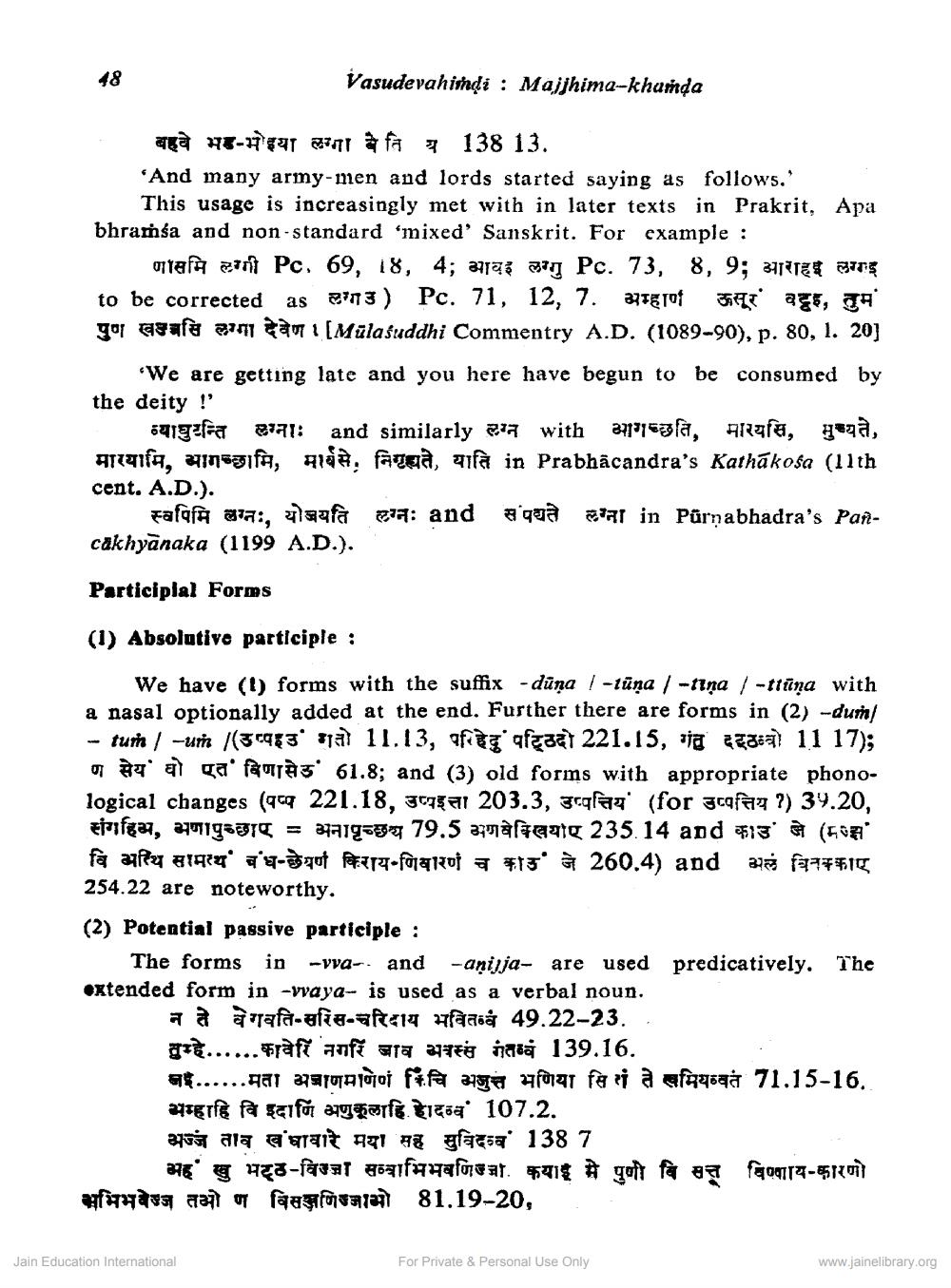________________
Vasudevahiindi : Majjhima-kharinda
बहवे भड-मोहया लग्गा बे ति य 138 13. 'And many army-men and lords started saying as follows.'
is usage is increasingly met with in later texts in Prakrit, Apa bhramsa and non - standard 'mixed' Sanskrit. For example :
___णासमि लगी Pc. 69, 18, 4; आवइ लग्गु Pc. 73, 8, 9; आराहई लगाइ to be corrected as लगउ) Pc. 71, 12, 7. अम्हाणे ऊसूर वट्टइ, तुम पुण खम्बसि लग्गा देवेण ! [Malasuddhi Commentry A.D. (1089-90), p. 80, 1. 20]
We are getting late and you here have begun to be consumed by the deity !'
व्याघुटन्ति लग्नाः and similarly लग्न with आगच्छति, मारयसि, मुच्यते, मास्यामि, आगच्छामि, मार्यसे, निगृह्यते, याति in Prabhācandra's Kathakosa (1lth cent. A.D.).
स्वपिमि लग्नः, योजयति लग्नः and संपते लग्ना in Parmabhadra's Pancakhyanaka (1199 A.D.).
Participlal Forms
(1) Absolutive participle :
We have (1) forms with the suffix - dūņa / -rūna / -tiņa / -träna with a nasal optionally added at the end. Further there are forms in (2) -dun/ - tum / -ure /(उप्पहउगतो 11.13, परिहेपट्ठिदो 221.15, गंतु ददठवो 1117); ण सेय' यो एत विणासे 61.8; and (3) old forms with appropriate phonological changes (पप्प 221.18, उप्पइत्ता 203.3, उप्पत्तिय (for उप्पत्तिय ?) 39.20, संगहिय, भणापुरुछाए = अनापृच्छय 79.5 अणवेक्खियोए 235.14 and काउ' जे (मझ वि अस्थि सामरथ बंध-छेयर्ण किराय-णिवारणं च का जे 260.4) and अलं विनक्काए 254.22 are noteworthy. (2) Potential passive participle :
The forms in -vva-. and -anijja- are used predicatively. The extended form in -vvaya- is used as a verbal noun.
नते वेगवति-सरिस-चरिदाय भवितवं 49.22-23. , तुम्हे......कावेरि नगरि जाव अवस्स गंतम्वं 139.16. नई......मता अजाणमाणेणं किंचि अजुत्त भणिया सिरा ते खमियम्वत 71.15-16. अम्हाहि वि इदाणिं अणुकूलाहि.हादव 107.2. अज्ज ताव खधावारे मया सह सुविदव 1387
मह खु भट्ठ-विज्जा सम्बाभिभवणिज्जा. कयाई मे पुणी वि सत्त विवाय-कारणो अभिमवेज तओ ण विसङ्गणिज्जाभो 81.19-20,
Jain Education International
For Private & Personal Use Only
www.jainelibrary.org




